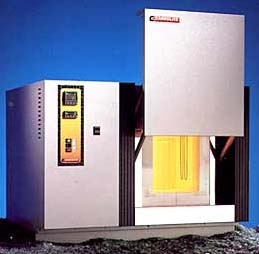| | |
| | ||
|
|
| |
| Introduction - Carbolite has been in the forefront of furnace design for the past 60 years and their range of high temperature furnaces is the most comprehensive available from a single source. There are over 50 standard models and several specialist products with maximum operating temperatures between 144 and 2050°C. The range sets new standards in performance, safety and quality of construction. Included in the range are silicon carbide heated furnaces to 1600°C and front and bottom loading models at 1700°C | and 1800°C which are heated by molybdenum disilicide (MoSi2) elements, manufactured by Kanthal and known as Kanthal Super. The ultra high temperature furnace is heated by Zirconthal elements which provide a furnace temperature of up to 2050°C in an oxidising atmosphere. Versions are available with electrically operated doors and a variety of controller and programmer options. | |
|
| ||
| The extensive general purpose range can be used for a wide variety of applications and in many different sectors of industry, test laboratories and research, examples include: Stylish and sturdy - - modern compact styling which minimises bench space. The case is constructed from zinc coated steel and finished in a hard wearing two-tone stoved epoxy/polyester powder coating. Convection cooling - an air gap between the insulation and outer case promotes convected air fow foor a cool outer case. All 1700 and 1800°C models are provided with fan cooling. Digital temperature control - the control module houses a range of digital instrumentation for precise temperature and process control. Push button setting with 1°C resolution. Programmers permit automated firing cycles. Chamber exhaust vent - promotes the extraction of fumes generated by the process. Postive break safety switch - isolates power to the elements when the door is opened. Solid state control - 1400-1600°C models have zero voltage power switching and rapid cycle time for smooth and reliable control. 1700°C and 1800°C models have phase angle fired thyristor stacks.
| Door action - a vertical counterbalanced door mechanism keeps the hot door insulation away from the operator when the door is opened; this is particularly important at high temperatures. The bottom loading models have the obvious advantage of raising the hearth into the heated chamber. Lightweight insulation - provides faster heating and cooling times, increasing productivity and energy efficiency. This is standard on most models. Service - aided by the simplicity of design; warning lights help diagnosis; easy access to consumable parts is provided. Options Note: The EMF output of thermocouples operating above 1600°C reduces significantly during the first 500 hours, resulting in the furnace temperature slowly rising. We therefore recommend regular calibration checks on these thermocouples. | |
| Chemical Attack! Furnaces are mostly made from oxides of aluminium (Al2O3 and SiO2). These oxides can be chemically attacked by some materials. The most common ones are:
| ||
